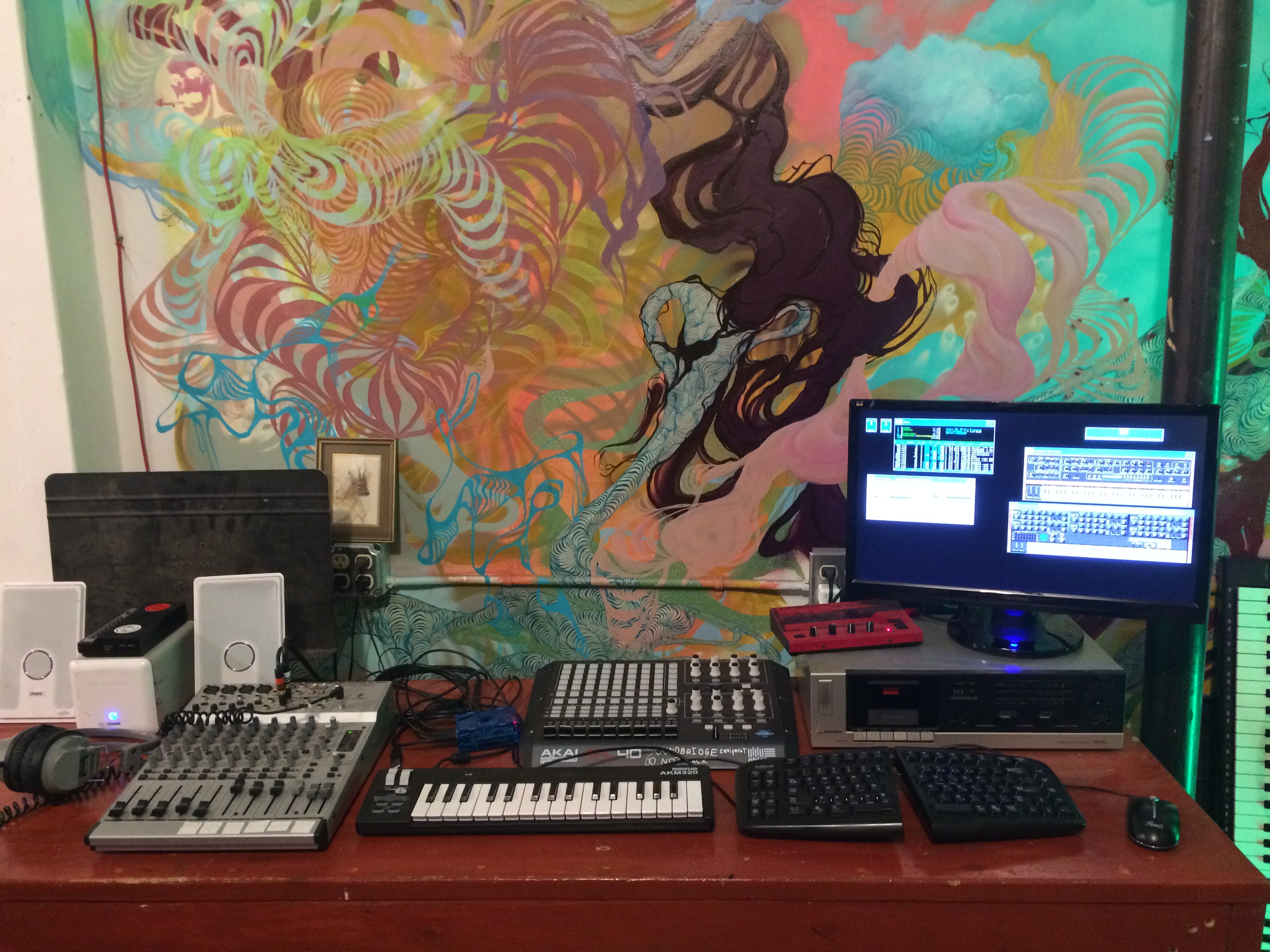Computer music workstation: Difference between revisions
(→MIDI) |
|||
| Line 43: | Line 43: | ||
==MIDI== | ==MIDI== | ||
There's an Akai APC40 that's floating around. It is known as a controller for the popular Ableton Live software, though it can also operate in "general purpose mode" by default. This means there is also a MIDI controller with 8 addressable faders, a crossfader, 16 CC1 knobs and a big matrix of buttons that produce note on/off messages. | |||
The monitor sits next to the [[Yamaha PSR-1700]] MIDI synthesizer and sequencer. Sound output works via the headphone jack or built in speakers. MIDI in/out work. It's possible to control Sunvox from the keyboard by opening the application on the PC and clicking the mouse on a generator in Sunvox. It's also possible to send MIDI to the keyboard and play lol karaoke files. | The monitor sits next to the [[Yamaha PSR-1700]] MIDI synthesizer and sequencer. Sound output works via the headphone jack or built in speakers. MIDI in/out work. It's possible to control Sunvox from the keyboard by opening the application on the PC and clicking the mouse on a generator in Sunvox. It's also possible to send MIDI to the keyboard and play lol karaoke files. | ||
Revision as of 12:23, 29 October 2016
The computer music workstation is a a Gateway PC with a Quad core Intel Core2 chipset on a VIA motherboard. Basically a PC you would build from parts circa 2008. It runs Debian Stretch (which is testing as of this writing). The MOTU 828 mkII is connected to it to provide some interesting options for audio I/O. The physical box is located under the Plan 9 workstation and the two share a monitor, but have separate mice and keyboards.
Specs
- Quad core 2.5 gHz Intel core2 64 bit CPU (fast)
- 4 GB RAM (no ECC)
- Debian GNU/Linux "stretch"
- 320 GB 7200 RPM SATA drive (No DAW Action for us)
- 1024 GB LaCie RAID-0 external storage via Firewire 400. (slow, if you want to DAW with this fine, you might lose your magic to bitrot)
- Fancy Nvidia graphics card (Vancy visuals)
- Firewire 400 PCI card for multichannel audio interface (pro audio)
- USB Wifi networking! (that's the little white thing on the back. it blinks green.)
Audio
There was a Denon home theater receiver on the hackshelves. I appropriated it for the power amps and myriad supported inputs. The main outputs of the MOTU 828 are wired to the STEREO CDR [Analog] source input of the Denon. There are some AudioChoice speakers that were on the floor by the west wing lounge. I made some custom cables and hooked them up to the A speaker output on the Denon.
There is a mixer called a Behringer Eurorack MX1604A. It is wired up to act like a 12 channel 4 bus analog mixer with two aux sends. The PC is sort of like the "mixdown" unit but we're not building a recording studio here! So who cares? Wiring diagram forthcoming.
Sometimes there is a Nord Micro Modular connected to the mixer. It accepts audio input as signal to presets 90-99. Many of these are vocoders and amplitude modulation or envelope follower. The input it attached to the mixer aux send 1. Any channel can send signal to the Nord, including the Nord, so WATCH OUT! Feedback warning. This is an excellent analog modeling synth, though the module editing interface is shit.
There's a turntable without a needle. It has a USB sound interface.
There is a cassette player for that vintage feel.
The computer depends on JACK for all sound routing and low latency operation. With our current hardware it's possible to get 96000 Hz @ 24bit 8 channel analog I/O with around 5 ms latency. More on the software stack when it's stabilized.
Software
- Supercollider (digital modular synthesis engine, object oriented DSP language and algorithmic composition environment)
- Sunvox (tracker style sequencer and DSP platform)
- Pure Data (patcher language control environment and realtime DSP engine for modular digital synthesis)
- Sonic Pi ( fun realtime loop composition environment with livecoding language based on Ruby)
- Audacity ( stereo sound recorder )
- LTSpice IV (Analog Circuit simulator)
- Plugins
- Carla (Plugin host)
- Bristol (Analog modeling synthesizer package)
Much of this software can be used to create digital models of classic synthesizers. The information in the modular synthesizer workshop applies to much of what can be built here using software.
MIDI
There's an Akai APC40 that's floating around. It is known as a controller for the popular Ableton Live software, though it can also operate in "general purpose mode" by default. This means there is also a MIDI controller with 8 addressable faders, a crossfader, 16 CC1 knobs and a big matrix of buttons that produce note on/off messages.
The monitor sits next to the Yamaha PSR-1700 MIDI synthesizer and sequencer. Sound output works via the headphone jack or built in speakers. MIDI in/out work. It's possible to control Sunvox from the keyboard by opening the application on the PC and clicking the mouse on a generator in Sunvox. It's also possible to send MIDI to the keyboard and play lol karaoke files.
